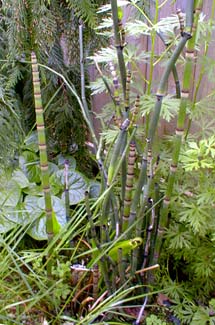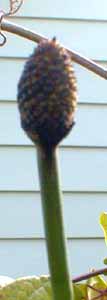
Scouring Rush Horsetail;
aka, Dutch Rush
 A primitive plant that has been in the world since the Age of Amphibians in Carboniferous swamp forests millions of years before the dinosaurs, Scouring Rush (Equisetum hyemale) grows from creeping rhyzomes & spoors. A March spoor-head is shown at right.
A primitive plant that has been in the world since the Age of Amphibians in Carboniferous swamp forests millions of years before the dinosaurs, Scouring Rush (Equisetum hyemale) grows from creeping rhyzomes & spoors. A March spoor-head is shown at right.As with other horsetails is potentially very invasive. It's common throughout North America & Europe. Though not native of Australia & New Zealand, it has escaped from cultivation & naturalized as a noxious weed.
Wherever it grows native anyway, it can do no harm, & makes a lovely garden ornamental.
So that it won't become a pest spreading its rhyzomes everywhere, I sank a five gallon plastic bucket in the ground, which does double-duty providing it with its no-drainage bog conditions. We soon had a large clump popping up between the lower branches of an Alaska Cedar, hemmed in by asarum wild gingers & monkshood & other shade plants.
After about three years, though, it successfully jumped the bucket, as I discovered it had popped up unnoticed on the other side of fence. Despite that this was on a retainer wall drop-off & dry as a bone, this new eruption of the scouring rush was doing just fine.
Evergreen hollow segmented stems stand extremely upright with only occasionally the forking branch, for the most part unbranching. Without being restricted by a container the spread can be limitless. The height in a restrained context is four feet, & sometimes six feet.
It likes sun or light shade with a preference for sun on the coasts. It generally requires perpetually damp or muddy soils, or even under two inches of water in a shallow pond, but is sometimes seen in dry areas or along railroad embankments because the vast root system reaches swamp populations that send water to less hospitably-located colonies. Hardy to minus 30 F., it is comfortable in zones 3 through 9.
It is regarded as edible, though eating large quantities can suppress the body's ability to metabolize Vitamin B. In moderation the strobil (fertile shoots) are an acceptable substitute for asparagus; the sterile shoots are not edible.
The plant also has many medicinal qualities including as an anti-inflammatory & diuretic. The stems contain silica, so that traditionally they were used to scour pots, hence the name Scouring Rush. Native Americans polished wooden utensils with it, & the first immigrants from Europe used it to polish pewter. It has sometimes been called "Shaving Rush" because of its use as an aftershave astringent. It has been used as a shampoo, & has insecticidal properties, thus functions as a flea & tick shampoo for pets.